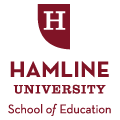Term
2011
Capstone
Thesis
Degree Name
MAESL
Primary Advisor/Dissertation Chair
Patsy Vinogradov
Secondary Advisor/Reader One
Julia Reimer
Peer-Reviewer/Reader Two
Paul Bruski
Abstract
Teachers of low-literate adult English language learners often use visual materials to teach content, but little research has been conducted on how these visuals are interpreted. This research explores the relationship between first language (L1) literacy and visual literacy, specifically the ability of adult ESL learners to identify the functions of graphic devices used in educational materials. The literature review examines how literacy and visual literacy are defined and discusses visual communication using the framework of semiotics. Through think-aloud interview sessions, Somali participants of varying L1 literacy levels interpreted illustrations from ESL materials. Results show lower than expected ability to interpret images and little difference in visual literacy between L1 literate and L1 non-literate participants. The author suggests that visual literacy is more dependent on experiential factors than on L1 education. Other findings include participants' tendency to bring real-world contexts to visuals and to interpret symbolic images as non-symbolic.
Keywords
Adult Education, ESL/ ELLs, Literacy
Recommended Citation
Bruski, Daniel J, "Do they get the picture?: Visual literacy and low-literacy adult ESL learners" (2011). School of Education and Leadership Student Capstone Theses and Dissertations. 468.
https://digitalcommons.hamline.edu/hse_all/468


Comments
Creative Commons License: CC BY-NC-ND 4.0